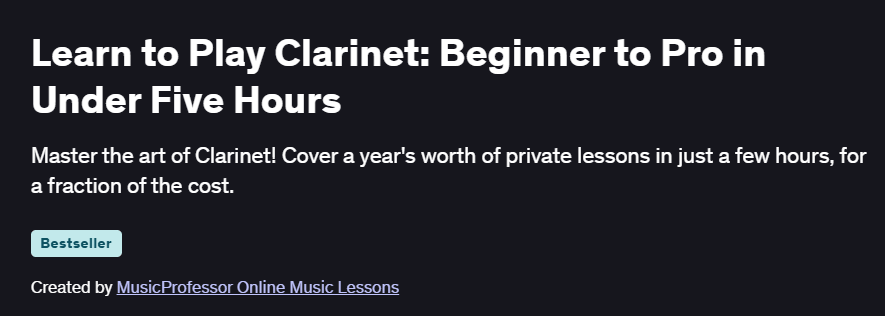What will you learn in Learn to Play Clarinet: Beginner to Pro in Under Five Hours Course
Assemble and care for your clarinet, including proper cleaning, reed selection, and maintenance
Form a correct, strong clarinet embouchure and develop breath‐control techniques for a clear, resonant tone
Read and interpret standard music notation and map notes on the staff to clarinet fingerings with animated charts
Play dozens of familiar melodies and songs, from first tunes to popular exercises
Perform major scales and scale exercises to build technical facility and muscle memory
Learn basic music theory concepts—rhythm, key signatures, and phrasing—to support your playing
Program Overview
Module 1: Assembly & Maintenance
⏳ 30 minutes
Topics: Clarinet parts, assembly/disassembly steps, cleaning routines, and reeds overview
Hands-on: Disassemble your clarinet, clean each part using recommended tools, and reassemble it correctly
Module 2: Embouchure & Tone Production
⏳ 45 minutes
Topics: Lip and jaw positioning, diaphragm breathing exercises, and tone-production mechanics
Hands-on: Practice long-tone and embouchure drills to achieve a consistent, full-bodied sound
Module 3: Music Notation & Fingering Charts
⏳ 45 minutes
Topics: Note values, key signatures, reading staff notation, and animated fingering charts
Hands-on: Play and sustain notes across registers following animated fingering demonstrations
Module 4: Melodies & Songs
⏳ 1 hour
Topics: Step-by-step learning of familiar tunes—from folk songs to simple classical melodies
Hands-on: Perform selected melodies hands-together with accompanying sheet music
Module 5: Scales & Technique Exercises
⏳ 30 minutes
Topics: Major scale fingerings in all common keys, slurred vs. tongued articulation
Hands-on: Run through scale exercises and technique drills to build dexterity and accuracy
Module 6: Music Theory & Troubleshooting
⏳ 30 minutes
Topics: Basic rhythm patterns, phrasing tips, common beginner pitfalls and clarinet-specific troubleshooting
Hands-on: Complete theory quizzes and apply fixes (e.g., adjusting reed alignment) to improve sound
Get certificate
Job Outlook
Clarinet Teachers (U.S. average): $74,530 per year
Orchestral Clarinetists: Regional orchestras typically pay $25k–$35k annually; top ensembles range $60k–$90k
Session & Freelance Work: Hourly rates vary $20–$45 per hour depending on setting and experience
Demand exists in orchestras, bands, studio recordings, private instruction, and music education.
Specification: Learn to Play Clarinet: Beginner to Pro in Under Five Hours Course
|
FAQs
- You’ll gain a strong foundation, not full mastery, in that time.
- The course uses a focused, step-by-step teaching method.
- Lessons prioritize essential fingerings, tones, and breathing.
- You’ll quickly learn to play basic tunes and scales.
- No, a student or beginner model clarinet is perfectly fine.
- The course teaches how to choose and care for affordable options.
- Quality mouthpieces matter more than luxury instruments.
- You’ll also learn basic setup and maintenance techniques.
- Renting a clarinet can be a good temporary option.
- Basic music reading is introduced in a practical way.
- You’ll learn note names, rhythm values, and symbols.
- The course ties reading directly to clarinet fingerings.
- It helps you connect written notes with physical playing.
- You’ll gain enough reading skill to learn new songs confidently.
- Common tone issues are addressed with simple breathing tips.
- You’ll learn proper mouth position and embouchure control.
- Exercises focus on tone clarity and breath consistency.
- The instructor shares easy fixes for squeaks or airy sounds.
- Patience and repetition help you find your personal sound fast.
- Yes, it’s designed for learners of all ages.
- The lessons are simple, visual, and step-based.
- Kids can follow along with minimal supervision.
- Adults with no music background can learn comfortably.
- The pacing supports absolute beginners with clear guidance.





